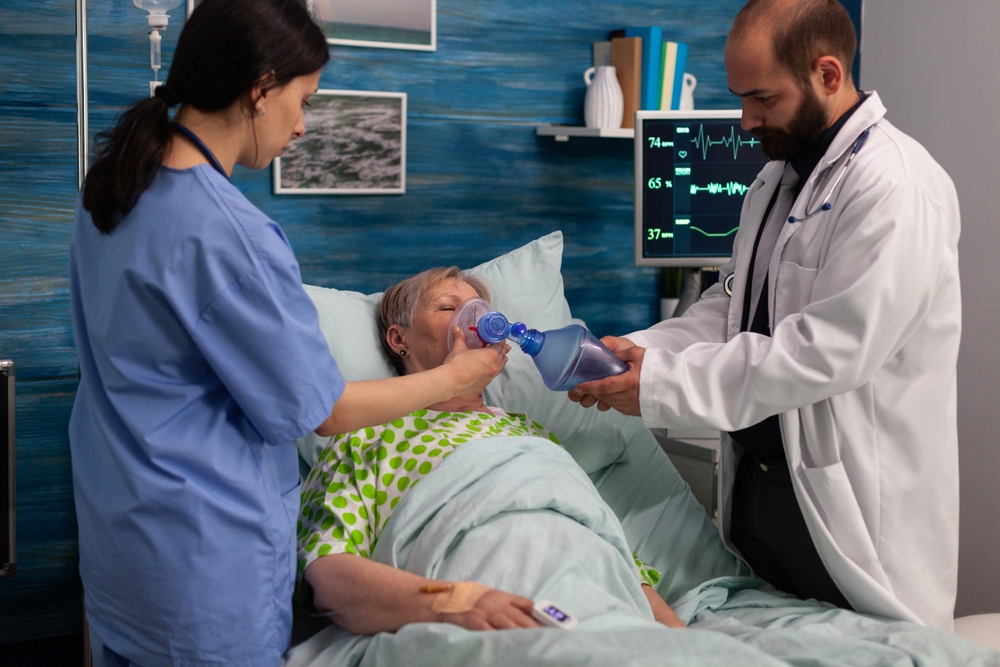Respiratory failure is a medical condition characterized by the body’s inability to maintain adequate gas exchange, leading to insufficient oxygen delivery to the tissues and inadequate removal of carbon dioxide from the bloodstream. As per Lung Specialist in Vijayawada, it is classified into two main types: hypoxemic respiratory failure, where there is a significant drop in oxygen levels (PaO2), and hypercapnic respiratory failure, where carbon dioxide levels (PaCO2) rise above normal, often due to inadequate ventilation. Causes of respiratory failure can be diverse and include chronic obstructive pulmonary disease (COPD), pneumonia, asthma, lung injuries, and neuromuscular disorders, among others.
How to identify respiratory failure, suggestions by Pulmonologist in Vijayawada ?

- Shortness of Breath: Patients may experience rapid and labored breathing, often referred to as dyspnea, which can be sudden or progressive.
- Cyanosis: A bluish tint to the skin, lips, or fingernails indicates low oxygen levels in the blood and is a critical sign of respiratory distress.
- Confusion and Altered Mental Status: Insufficient oxygen supply can lead to confusion, agitation, or lethargy due to cerebral hypoxia.
- Increased Heart Rate: Tachycardia may occur as the body attempts to compensate for low oxygen levels by increasing blood circulation.
- Use of Accessory Muscles: Labored breathing may cause patients to engage additional muscles in the neck or abdomen, indicating respiratory distress.
- Abnormal Breathing Patterns: This includes irregular breathing rates or patterns, such as Cheyne-Stokes respiration, which can indicate more severe respiratory compromise as told by Pulmonology Specialist in Vijayawada .
What could be the reasons behind respiratory failure ?
- Obstructive Lung Diseases: Conditions like chronic obstructive pulmonary disease (COPD) and asthma can lead to increased airway resistance, impairing airflow and resulting in respiratory failure as seen in Pulmonology Hospital in Vijayawada .
- Restrictive Lung Diseases: Diseases such as pulmonary fibrosis and sarcoidosis limit lung expansion, leading to insufficient ventilation.
- Neuromuscular Disorders: Conditions like amyotrophic lateral sclerosis (ALS) and myasthenia gravis affect the muscles involved in breathing, causing respiratory muscle weakness.
- Central Respiratory Depression: Conditions like drug overdose (especially opioids) or brain injuries can depress the respiratory centers in the brain, impairing the drive to breathe needing Respiratory Medicine in Vijayawada .
- Pneumonia: Severe infections can fill the alveoli with fluid, hindering oxygen exchange.
- Pulmonary Embolism: Blood clots in the pulmonary artery can obstruct blood flow, leading to decreased oxygenation.
- Acute Respiratory Distress Syndrome (ARDS): A severe inflammatory response in the lungs can disrupt normal respiratory function, causing failure.
Different levels of respiratory failure as per Best Lung Doctor in Vijayawada :
- Mild Respiratory Failure: In this initial stage, patients may experience slight hypoxemia with PaO2 levels dropping below normal (typically < 60 mmHg). Symptoms may include mild exertional dyspnea and tachycardia.
- Moderate Respiratory Failure: As the condition progresses, oxygen levels continue to decline, leading to increased respiratory effort and pronounced dyspnea. The patient may start to exhibit confusion or agitation due to reduced oxygen supply.
- Severe Respiratory Failure: Characterized by significant hypoxemia (PaO2 < 40 mmHg) and/or hypercapnia (PaCO2 >50 mmHg). Patients often become lethargic, unable to maintain their airway, and potentially require mechanical ventilation for support.
- Acute Respiratory Distress Syndrome (ARDS): This stage signifies a critical situation where there is widespread inflammation and fluid accumulation in the alveoli, severely impairing gas exchange, leading to rapid deterioration in a patient's condition.
- Chronic Respiratory Failure: Develops gradually over time due to chronic lung diseases like COPD or interstitial lung disease, leading to persistent hypoxemia and/or hypercapnia. Management often includes long-term oxygen therapy and lifestyle modifications.
Treatment options for respiratory failure:
- Oxygen Therapy: Administering supplemental oxygen can improve oxygen levels in the blood for patients experiencing hypoxemia, using nasal cannulas, masks, or ventilators.
- Non-Invasive Ventilation (NIV): Techniques like CPAP (Continuous Positive Airway Pressure) and BiPAP (Bilevel Positive Airway Pressure) provide positive pressure to the airways, assisting breathing without the need for intubation.
- Mechanical Ventilation: In cases of severe respiratory failure, intubation and mechanical ventilation may be necessary, allowing a machine to take over the work of breathing.
- Bronchodilators: These medications relax airway muscles, improving airflow and are particularly effective in conditions like COPD and asthma.
- Corticosteroids: Used to reduce inflammation in the airways, corticosteroids can be crucial for managing conditions like pneumonia or severe asthma exacerbations.
- Pulmonary Rehabilitation: A structured program including physical therapy, education, and nutritional support can enhance lung function and quality of life in chronic respiratory patients.
- Underlying Causes: Treating conditions such as pneumonia, blood clots, or congestive heart failure directly can help alleviate respiratory failure symptoms. Consult Dr. Sri Teja Bollu for more information.
Newsletter
Subscribe our Newsletter to get new updates
